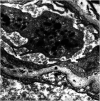Pathogenesis of Pulmonary Hemorrhagic Syndrome in Human Leptospirosis
- PMID: 33872210
- PMCID: PMC8176490
- DOI: 10.4269/ajtmh.20-1000
Pathogenesis of Pulmonary Hemorrhagic Syndrome in Human Leptospirosis
Abstract
Based on a previous study and by incorporating new knowledge, the goal of our study was to understand more fully the pathogenesis of hemorrhagic pneumonia of severe human leptospirosis, highlighting the onset of capillary lesions by Leptospira itself and/or its antigenic/toxic products acting on the endothelium and binding to cadherins. Both events lead to loss of endothelial integrity, alter permeability, cause rupture, and open intercellular junctions, contributing to the hemorrhagic phenomena associated with severe leptospirosis.
Figures






References
-
- Ministério da Saúde , 2020. Available at: https://antigo.saude.gov.br/images/pdf/2020/fevereiro/07/obito-lepto-200....
Publication types
MeSH terms
LinkOut - more resources
Full Text Sources
Other Literature Sources
Medical

